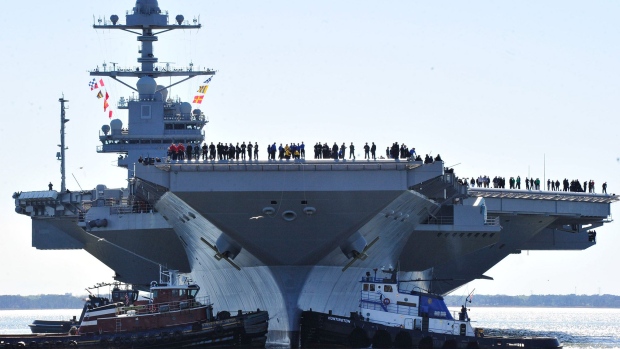Aug 5, 2020
Next Carrier’s Cost Creeps Up After First One Hit $13.3 Billion
, Bloomberg News

(Bloomberg) -- The Navy vowed that a runaway budget wouldn’t be allowed again after the USS Gerald Ford, the first in a new class of aircraft carriers, cost a record $13.3 billion. Now, the price for the second ship is creeping up.
The service’s estimate for shipbuilder Huntington Ingalls Industries Inc. to design and construct the USS John F. Kennedy has increased to $3.58 billion, up 7% from the $3.35 billion contract awarded in 2015, according to the carrier program’s Selected Acquisition Report for fiscal 2021.
That underscores previous warnings that the fully outfitted carrier may exceed an $11.4 billion cost cap imposed by Congress. The contractor is falling short by a key measure of labor efficiency, the Navy said in the report obtained by Bloomberg News.
Its workforce performed 91 cents of work for every Navy dollar spent in the last year, down from the more acceptable level of 95 cents per dollar over the same timeframe, according to the report.
Huntington Ingalls also is falling short of a Navy goal to reduce cumulative labor hours by at least 18% from the first ship. With the vessel 69% complete, the Kennedy is performing at a 16% improvement over the Ford at the same point, Captain Danny Hernandez, a Navy spokesman, said in an email.
Hernandez said the cost report’s figures stem in part from changes such as improvements in warfare capability and lessons learned from the Ford’s recent post-delivery “shakedown” sea trials. There are additional costs “from congressional direction” requiring that the Kennedy be capable of deploying with F-35 jets by mid-2025, he said.
The cost increases are also “due to delays relating to electrical, sheet metal, painting and platform engineering work,” the Navy said in the Selected Acquisition Report. The JFK is expected to be delivered in 2024.
‘Exhausted’ Budget
But the report warned that “if the current cost performance continues, then the budget will be exhausted prior to the completion” of the carrier. That could force the Defense Department to make the case to lawmakers for easing the cost cap.
Beci Brenton, a spokeswoman for Newport News, Virginia-based Huntington Ingalls, said the carrier’s construction is about 72% complete. The company “continues to see the benefits associated with significant build strategy changes and incorporation of lessons learned” from its predecessor.
“We track cost and schedule trends continuously and share that information with our customer,” the Navy, Brenton said. The company reports earnings Thursday.
Shelby Oakley, an acquisition director for the Government Accountability Office, said in an email that “our past work has shown that during the last phases of construction, programs generally experience their highest levels of cost growth as they are finishing the detailed stages of construction.”
Earlier, the cost of the Ford soared as it was plagued by technical problems with its combat systems. Since 2008, its cost has increased $2.8 billion amid congressional criticism.
The Navy needs to retain congressional and public support to boost funds for shipbuilding if it’s to achieve its goal of a 355-ship fleet, up from 300 today.
The newly disclosed information indicates construction cost performance on the second carrier “has been eroding gently over time,” said Ronald O’Rourke, naval analyst for the non-partisan Congressional Research Service. He said “the Navy believes there is more than a 50% chance that the ship will experience cost growth” driving it above the $11.4 billion congressional cap.
The cap is supposed to apply to the fully outfitted ship, including its nuclear reactor, aircraft launch and recovery systems and radar system.
O’Rourke’s assessment matches that of the Congressional Budget Office, which in October said the Navy informed it “that there is a greater than 60% chance that the ship’s final cost will be more than the current estimate.”
©2020 Bloomberg L.P.


